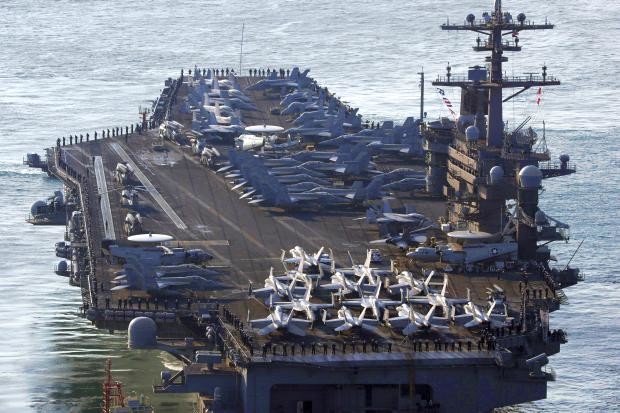US show of force to North Korea also could show US weakness

In this photo, taken March 15, 2017, a US Navy aircraft carrier, the USS Carl Vinson, approaches to participate in the annual joint military exercise called Foal Eagle between South Korea and the United States, at Busan port in Busan, South Korea. The Pentagon says a Navy carrier strike group is moving toward the western Pacific Ocean to provide a physical presence near the Korean Peninsula. North Korea’s recent ballistic missile tests and continued pursuit of a nuclear program have raised tensions in the region, where US Navy ships are a common presence and serve in part as a show of force. The US Pacific Command directed the carrier group, that includes USS Carl Vinson, to sail north to the western Pacific after departing Singapore on Saturday, April 8, according to a Navy news release. (Photo by JO JUNG-HO / Yonhap via AP)
WASHINGTON, DC — Upping the stakes in its slow-burning confrontation with North Korea, the Trump administration deployed an aircraft carrier to the region this week in a show of force that also could expose American weakness. If the North proceeds with a ballistic missile or nuclear test and the US does nothing in response, America’s deterrence will appear diminished.
The USS Carl Vinson is steaming to waters off the Korean Peninsula as anticipation mounts that Kim Jong Un will stage another weapons test around the anniversary of the birth of his grandfather, Kim Il Sung, the nation’s founder, on Saturday. Another potential date: An April 25 celebration of its armed forces.
Tensions are high on the divided peninsula. The North sees US-South Korea war games as preparations for an invasion. The US and its allies have expressed alarm about Pyongyang’s recent ballistic missile launches, including a four-rocket salvo last month it described as a practice to strike US bases in Japan. Washington’s ultimate concern is the North’s developing ability to mount a nuclear warhead on an intercontinental missile, which it should be able to master in the next few years.
At the Pentagon Tuesday, Defense Secretary Jim Mattis said sending the Vinson was “prudent.”
And Army Gen. Vincent Brooks, commander of US forces in South Korea, decided not to come to Washington for congressional hearings this month, his office said Tuesday, suggesting he had to stay for a potentially hazardous situation under his command. US defense officials said that didn’t mean military action was imminent. A similar decision was made amid tensions in 2013.
But the Vinson’s presence near North Korea points to the larger challenge for the US of deterrence, which has to be backed by the real threat of force. No one has spoken of shooting down a North Korean missile unless it directly threatens the US or its allies in East Asia. And Kim is likely to be undeterred to conduct tests because he has made nuclear weapons development a national priority, seeing them as a guarantee against US-backed regime changes that have toppled authoritarian regimes in Iraq, Libya and elsewhere.
President Donald Trump’s policy toward the North Korean threat is still taking shape. The emphasis has been on pressing China to use its economic leverage to rein in its wayward ally. When Chinese leader Xi Jinping met Trump in Florida last week, the US urged China to block North Korea’s access to the international financial system by cracking down on banks and companies that deal with it.
But the Trump administration has been unusually outspoken about retaining pre-emptive military options against North Korea. The president has issued repeated, ambiguous warnings about his willingness to take unilateral actions – a threat that assumed new resonance after he ordered a missile strike against Syria last week over its alleged use of chemical weapons. The order was issued during Xi’s visit.
“North Korea is looking for trouble. If China decides to help, that would be great. If not, we will solve the problem without them! U.S.A.,” Trump tweeted Tuesday.
The United States periodically deploys aircraft carrier strike groups to waters near the Korean Peninsula to retain a naval presence and project power in the Asia-Pacific region. The Carl Vinson took part last month in the ongoing US-South Korea war games.
President Barack Obama also ordered an aircraft carrier to the Korean Peninsula in a show of force in November 2010 after North Korea launched a deadly artillery barrage on the South. Then, the fear was a conflagration at the heavily militarized border.
Washington now views the threat as one against the US itself, as North Korea’s nuclear and missile programs approach the capacity to reach the US mainland. That has raised the question of whether the US would be prepared to shoot down a North Korean missile. Doing so would be a real-world test of America’s uncertain missile defense capabilities.
The Carl Vinson is accompanied by a destroyer ship with an Aegis combat system to track and intercept missiles.
John Park, director of the Korea Working Group at the Harvard Kennedy School, said if North Korea went ahead with a missile test to mark this weekend’s anniversary, there would be questions if the US was in the region but did not try to stop it. If it uses the Aegis system, a failure would hurt the system’s credibility.
That would also alarm allies Japan and South Korea, which also have the Aegis.
Even if the US used the missile defense system successfully, the question would be how Pyongyang responds.
Escalation into a full-blown conflict would leave South Korea’s capital, 40 kilometers (25 miles) from the heavily militarized border, vulnerable to the North’s artillery and rockets. Nearly 30,000 US forces in South Korea, many accompanied by families, would also be in the firing line.
In a statement Tuesday, North Korea’s Foreign Ministry said the aircraft carrier deployment “goes to prove that the US reckless moves for invading … have reached a serious phase.”














